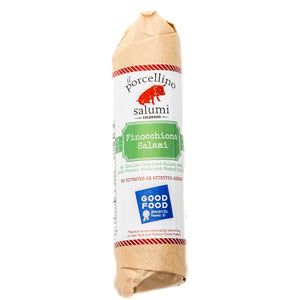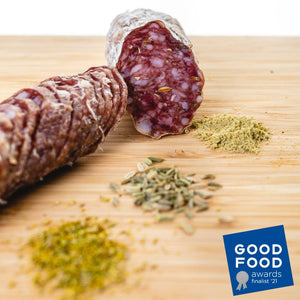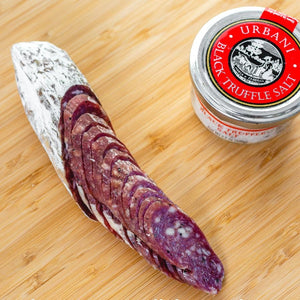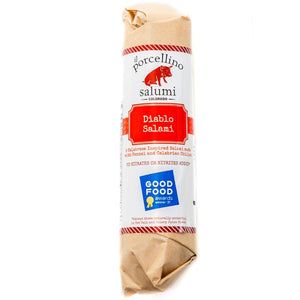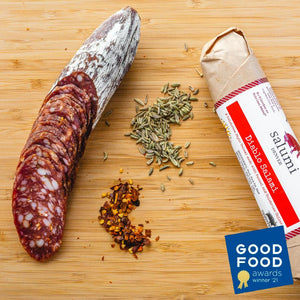If you've ever stepped into our store or followed us on Facebook or Instagram, you've seen many different types of cured meat hanging and lying around in all its glory. You've probably seen big pork legs, shoulders, cheeks, fatty muscle slabs, plus smaller tube format cured meat in natural casings. In general, there are two categories of cured meat: whole muscle and salami.

We create a lot of whole muscle cured meat options, but as of now, our salami is what you'll find at our online store and grocery stores around the country.
Whether you call cured meat charcuterie or our preferred term, salumi, it all includes salami. The term salami has Italian origins, but many countries and regions developed their version of salami which I'll break down below.
What kind of meat is in salami?
Traditionally salami is made of pork, but it can be made with beef, lamb, duck, bison, goat, wild boar, elk, and more. Salami generally has a marbled appearance and was developed as a way to preserve meat without refrigeration. Salami is older than ancient Rome, and over the centuries, many variations and production processes have created different types and flavors.
98% of the products that we make at our wholesale facility are made from pork. We recently started to introduce some beef and duck into our whole muscle curing program. At our deli and retail store in Denver, we make various products that include Wagyu Beef Bresaola, Duck Prosciutto, Lamb Coppa, and Lamb Prosciutto.
What is the white stuff on salami?
The white stuff on the exterior of our salami is a penicillin-based mold that is the same mold that you find on the exterior of some cheeses like brie. It is 100% edible. However, we do recommend removing the casing that has the mold on it before consumption.

The function of the white mold is to protect the salami from any harmful bacteria getting inside the salami during the fermentation and drying processes. It does create its own unique flavor and aroma, or "terroir," associated with our particular salami. Occasionally we will see green mold appear on our salami, and there is nothing wrong with it. The green mold is the same mold that you see in blue cheese. Again, 100% edible, but we recommend removing the casing it's on.
How long does salami last?
How long salami lasts is variable and depends on the producer and their methods. In general, salami lasts a long time, like months to years.
In general, we always recommend refrigerating the salami you purchase or following the package instructions. We feel like our salami stays fresh for approximately nine months, and we recommend keeping it wrapped in the paper packaging and stored in your fridge crisper drawer.
Is salami bad for you?
This is a regular question and one we've discussed in our cured meat guide. The overall answer is no, salami is not bad for you, but we can't speak for everyone's dietary restrictions. Some salami will have higher sodium content than others. If you have concerns, I recommend speaking with your doctor, who knows your health history.
Is the salami casing edible?
Most salami casings are edible and can either be natural or artificial. Natural casings are usually animal intestines or skin which are thoroughly cleaned before being stuffed. Artificial casings are generally made of collagen, cellulose, or plastic and may not be edible. We recommend reading the product label to be sure.
The casings that we stuff our salami into are 100% natural and indeed edible. We use a 50/55 mm beef middle to stuff our retail size salami. With our entire process, we feel that using a natural casing vs. an artificial casing allows us to produce a 100% all-natural product instead of other makers that do use artificial casings.
How do I remove the salami casing?
I remember sitting down for a salami snack on a long day hike to find out that I forgot my pocket knife. Tearing into the salami with my teeth wasn't ideal, and I'm sure anyone passing got a laugh as they watched me gnaw on a tube of salami. In the end, the salami was still delicious, and I satisfied my hunger, but I'd like to avoid doing it again.
The easiest way to remove the casing is to cut off a small piece at either end of the salami and then make a shallow cut down the center starting at the cut-off end. Ensure the cut down the center doesn't go too deep and goes the long-way and not around the salami. From there, you can peel back the edges to expose however much of the salami meat you want to slice for eating.

Traditional Types of Salami
There are hundreds of different salami variations from around the globe. Below are some of the more popular traditional salami, but it by no means encompasses all the varieties. People are always experimenting with flavors, ourselves included, and we encourage you to look for salami beyond what is listed below.
Genoa: A dry-cured salami from the Genoa region of Italy typically made of pork, salt, garlic, pepper, fennel seeds, and wine.

Finocchiona: A spicy salami typically from the Tuscan region characterized by the use of fennel.

Pepperoni: An Italian American salami famous on pizza and often noted for the use of hot spices.

Soppressata: A well-known Italian salami that often varies in flavor, texture, and ingredients depending on the region where it's made.

Rosette de Lyon: Born out of France's Lyon region and named for generally having a rose-colored appearance.

Saucisson Sec: A traditional French salami accented by the use of garlic and pepper.

Saucisson Basque: A coarse ground dried salami from France's Basque area and highlighted with Espellete Pepper.

'Nduja (en-DOOj-yah): A spicy and spreadable pork salami from Italy. Its popularity in the United States is growing for a good reason.

What sets il porcellino's salami apart from the rest?
We at il porcellino salumi pride ourselves on our approach to making salami the natural way. It all begins with the beautiful heritage breed pork that we use from Red Top Farms. Specifically, we prefer the Berkshire breed of hog to make our handcrafted, artisanal, small-batch salami. The animals are raised ethically and sustainably on small family farms in the Upper Midwest, never administered antibiotics or growth hormones, fed a vegetarian diet, and given a good life.
We are proud to source premium spices and use nothing but the finest ingredients for our salami. Italco Foods brings in the freshest spices directly from Italy, and we use them immediately to pull out the maximum flavor. Fennel Seed and Juniper Berries get toasted before use as well to truly liven the flavors.
We source locally made wine from Carboy Winery in Littleton, small-batch whiskey from Woody Creek Distillers in Basalt, and Breckenridge Brewery Beer for our beer brats. We love supporting other like-minded companies in Colorado.
At our own USDA processing facility in Basalt, Colorado, we hand trim all of the meat to remove unwanted sinew and glands in the meat. We hand mix our spices for each small batch, use celery juice powder and sea salt for our curing agents, and grind the meat in small batches. Our salami gets stuffed into all-natural casings, hand-tied by our team of salumieres, and slowly fermented to bring out the maximum flavor in this critical phase of production. The salami hang-dries in our climate-controlled rooms for 5 - 8 weeks, depending on the salami's size.
Everything gets packaged by hand, which includes brushing off some of that white mold and separating the salami tied together in strands of two to three. Labeling is done by hand as well. Literally, every product is handcrafted with attention to detail being priority number one!


